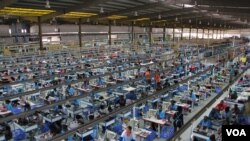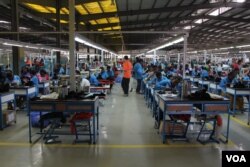For a long time, economists have discussed East Africa's chances to "get a foot in the door" of global manufacturing. China, as the world's leading hub for mass production, has become expensive due to rising labor and energy costs. Meanwhile, East Africa offers a large young and cheap labor force. Until recently though, delays at ports, bad roads, power outages and political instability have prevented a shift from happening. But now, the Ethiopian government is building new industrial mega-zones that have successfully attracted some foreign investors who are moving manufacturing from China.
He Pingting, who goes by the American name Claire, gives a tour of the new factory building of George Shoe PLC. The Taiwanese shoe manufacturer started operating some months ago and recently exported its first container: 15,000 pairs of pink and light-blue women's shoes made in Ethiopia.
He Pingting says the main challenge is the language barrier.
"We have so many stitchers. So, there are so many skills they need to learn. But, you know, teach them is a little bit hard because the language. …but no matter, we have a translator here and they're very collaborative," she said.
The factory is filled with a scent of glue. Young men and women in blue overalls sit in front of sewing machines and along assembly lines. Seven hundred Ethiopians work under Chinese and Taiwanese supervision: eight hours a day, six days a week for 800 to 1,200 Birr a month, which is about $60 (US), a fraction of a laborer's wage in China.
Bole Lemi industrial zone
The factory building lies on the outskirts of Addis Ababa in a new gigantic 156-hectare industrial zone, called Bole Lemi. It is only one of a handful of new planned zones across the country. After the completion of the second phase - another 186 hectares - Bole Lemi may offer up to 100,000 jobs.
Ethiopia is feverishly working on becoming the world's newest hub for manufacturing and has good chances.
"Pakistan, Indian, Taiwan, Korean, Chinese. All are there," he said. "You see the under-construction area, sheds are already contracted out. All leased now, all are leased. For instance this one, about 11,000 square meters, the next one 5,500 square meters. And we focus on this area for garment, especially garment, for garment and shoe, glove," said Shiferaw Solomon, the director-general of the Ethiopian government's Investment and Industrial Zone Corporation.
Behind Shiferaw Solomon outside the factory building, construction workers are working on two dozen new sheds that are to be ready by the end of August, a bit behind schedule. According to the Ministry of Industry, 20 foreign companies have secured factories at the site.
Fast growing economy
Ethiopia currently has one of Africa's fastest growing economies. Unlike others, it is not driven by natural resources, but large public investments with foreign money. Shiferaw is optimistic that the government's new industrial mega-zones and expansion of the textile and leather industry will give the country another push.
"We have abundant lands, abundant labor forces, materials, raw materials. Now, we're at a stage of opening up," said Shiferaw Solomon.
Driving out of the industrial zone, he foresees the potential his country has for the entire region. Already a rising political power, with a massive peacekeeping force in Somalia and other parts of the region, Ethiopia - Africa's second-most populous country with more than 90 million people - is now also heading towards a new economic age.
"I'd like and I hope to see in the future Ethiopia is one of the competing countries, interesting countries and it serves as a hub for African at large," said Shiferaw Solomon.
But the development comes with a price. Shiferaw says Addis Ababa and the entire country will suffer from power shortages for one or two years when all companies are operating.










